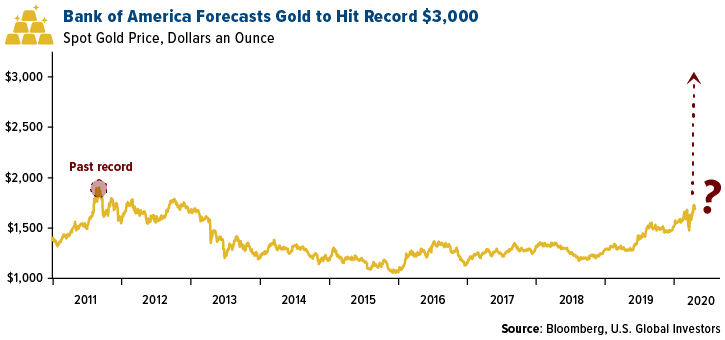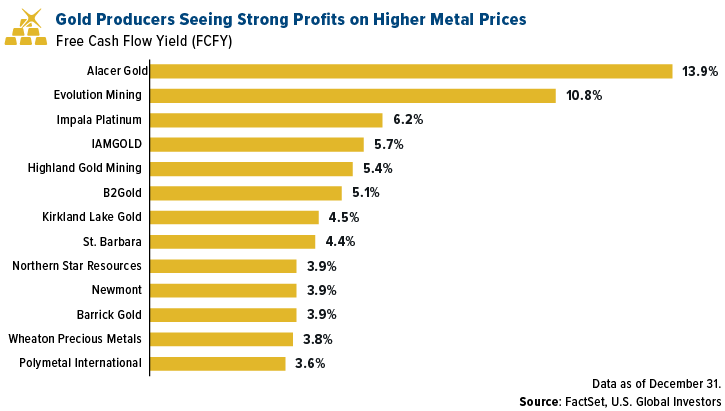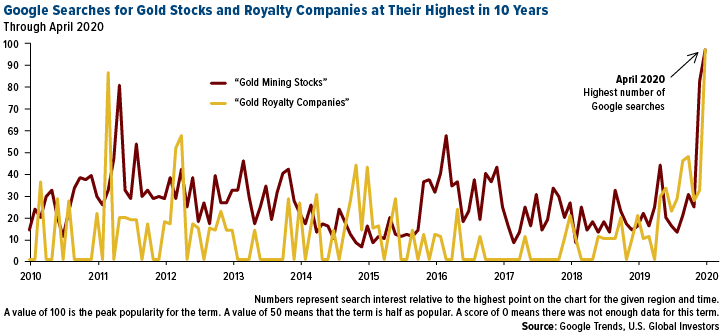
Gold has continued to catch a bid, nearing seven-and-a-half-year highs, on a host of head-spinning economic news stemming from the global coronavirus pandemic.
A staggering 26.4 million people, or about 15 percent of the U.S. workforce, have lost their jobs since mid-March. The price of oil went negative for the first time ever – falling to as low as negative $37 per barrel. The composite purchasing manager’s index (PMI) dropped to 27.4 in April – a record low. To help stem some of these economic woes, the U.S. is printing money on a scale we’ve never seen before. The amount of M2 money supply rose 16 percent year-over-year as of April 13 and the budget deficit is already at 18 percent of GDP.
All of this could be constructive for the price of gold, which we believe is on a path to exceed its previous record of $1,900 an ounce. Analysts at Bank of America now see the precious metal touching $3,000 within the next 18 months. And if that happens, just wait and see what gold mining companies could do.

Don’t Overlook Gold Mining Stocks
Shares of senior producers, as measured by the FTSE Gold Mines Index, are up close to 20 percent for the year, but for the 10-year period they still trail the metal’s spot price performance. We believe this makes the group an attractive investment opportunity, especially now that gold mining is one of the few industries generating strong revenues and free cash flow on higher metal prices. Record-low oil prices are also positive for miners in lowering operating costs.
With soaring unemployment, many S&P 500 stocks’ revenue could dry up soon. Gold stocks could shine, by comparison, and we could new buyers who focus on companies with free cash flow, one of the best metrics of profitability.
Take a look below. What you see are the most profitable precious metal mining stocks with a market cap of $1 billion or more, based on free cash flow yield (FCFY). This is a metric that basically tells you how much cash the business is generating after taxes relative to how much it costs to operate. The lower the number, the less cash it’s making. The higher the number, the more cash it’s making.
Included in this list are highly liquid, mega-cap producers like Barrick (3.9 percent FCFY) and Newmont (also 3.9 percent), smaller firms such as the Russian Highland Gold Mining (5.4 percent) and everything in between. One royalty company, Wheaton Precious Metals (3.8 percent), is also represented.
Topping the list is intermediate miner Alacer Gold, which released positive initial drill results in April at its Copper Hill project in Turkey. The Denver-based producer reported “impressive grades” at the site, with the copper close to the surface and “very low” in contaminates.

Don’t Overlook Gold Mining Stocks
Shares of senior producers, as measured by the FTSE Gold Mines Index, are up close to 20 percent for the year, but for the 10-year period they still trail the metal’s spot price performance. We believe this makes the group an attractive investment opportunity, especially now that gold mining is one of the few industries generating strong revenues and free cash flow on higher metal prices. Record-low oil prices are also positive for miners in lowering operating costs.
With soaring unemployment, many S&P 500 stocks’ revenue could dry up soon. Gold stocks could shine, by comparison, and we could new buyers who focus on companies with free cash flow, one of the best metrics of profitability.
Take a look below. What you see are the most profitable precious metal mining stocks with a market cap of $1 billion or more, based on free cash flow yield (FCFY). This is a metric that basically tells you how much cash the business is generating after taxes relative to how much it costs to operate. The lower the number, the less cash it’s making. The higher the number, the more cash it’s making.
Included in this list are highly liquid, mega-cap producers like Barrick (3.9 percent FCFY) and Newmont (also 3.9 percent), smaller firms such as the Russian Highland Gold Mining (5.4 percent) and everything in between. One royalty company, Wheaton Precious Metals (3.8 percent), is also represented.
Topping the list is intermediate miner Alacer Gold, which released positive initial drill results in April at its Copper Hill project in Turkey. The Denver-based producer reported “impressive grades” at the site, with the copper close to the surface and “very low” in contaminates.

Google Trends isn’t a leading indicator recognized by mainstream economists and market analysts, but we believe it shows where investors’ thinking may be at right now. This, coupled with growing retail buying of the physical metal, demonstrates that investors have faith in gold during these troubling economic times.
Receive a monthly recap of the gold market straight to your inbox by subscribing here.
The Purchasing Manager’s Index is an indicator of the economic health of the manufacturing sector. The PMI index is based on five major indicators: new orders, inventory levels, production, supplier deliveries and the employment environment.
The S&P 500 Stock Index is a widely recognized capitalization-weighted index of 500 common stock prices in U.S. companies.
The FTSE Gold Mines Index encompasses all gold mining companies that have a sustainable and attributable gold production of at least 300,000 ounces a year, and that derive 75% or more of their revenue from mined gold.
Free cash flow yield is a financial solvency ratio that compares the free cash flow per share a company is expected to earn against its market value per share. The ratio is calculated by taking the free cash flow per share divided by the current share price.
M2 Money Supply is a broad measure of money supply that includes M1 in addition to all time-related deposits, savings deposits, and non-institutional money-market funds.
